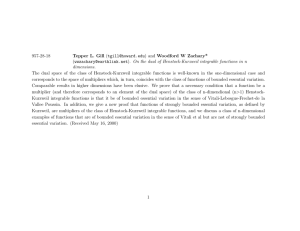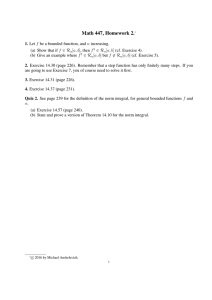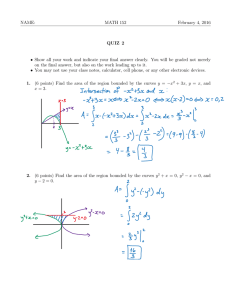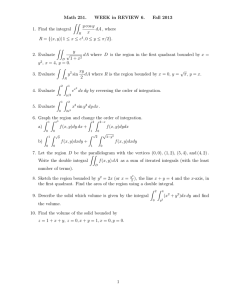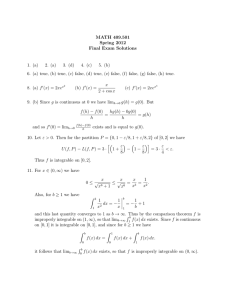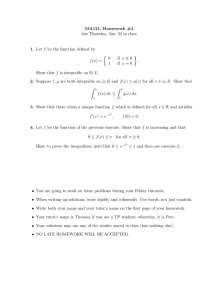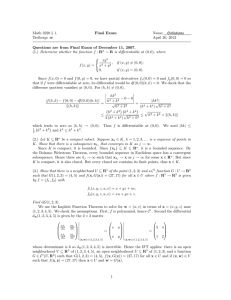18.100B, Fall 2002, Homework 8 solutions (1) Chapter 6, Problem 5
advertisement
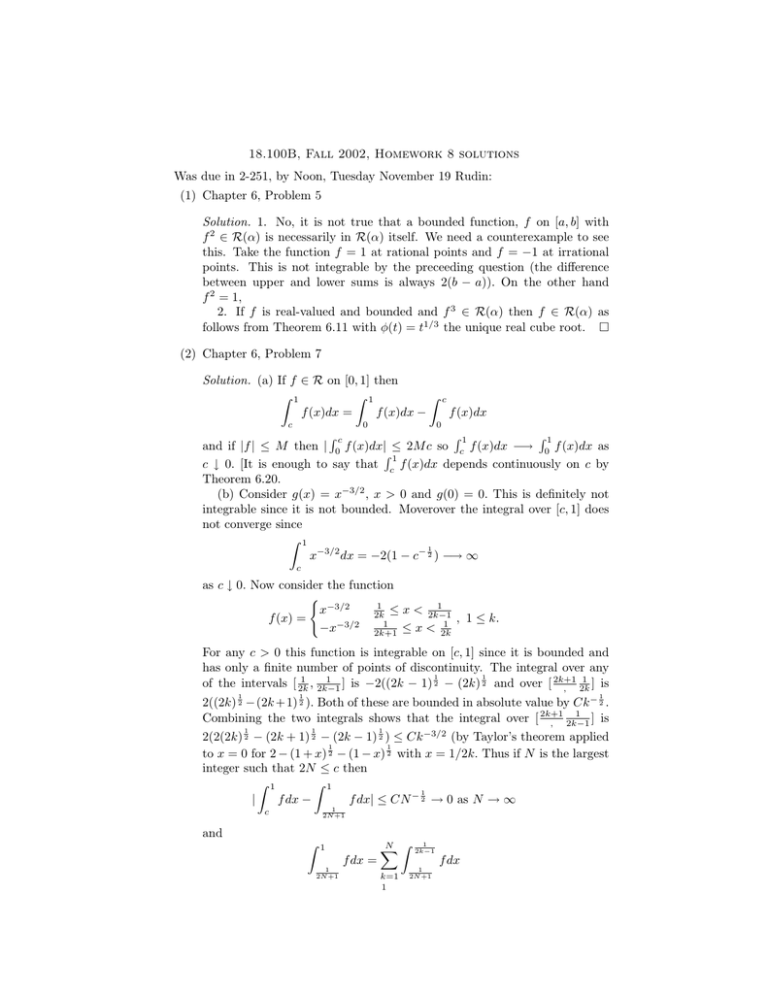
18.100B, Fall 2002, Homework 8 solutions Was due in 2-251, by Noon, Tuesday November 19 Rudin: (1) Chapter 6, Problem 5 Solution. 1. No, it is not true that a bounded function, f on [a, b] with f 2 ∈ R(α) is necessarily in R(α) itself. We need a counterexample to see this. Take the function f = 1 at rational points and f = −1 at irrational points. This is not integrable by the preceeding question (the difference between upper and lower sums is always 2(b − a)). On the other hand f 2 = 1, 2. If f is real-valued and bounded and f 3 ∈ R(α) then f ∈ R(α) as follows from Theorem 6.11 with φ(t) = t1/3 the unique real cube root. (2) Chapter 6, Problem 7 Solution. (a) If f ∈ R on [0, 1] then Z 1 Z 1 Z f (x)dx = f (x)dx − c 0 c f (x)dx 0 Rc R1 R1 and if |f | ≤ M then | 0 f (x)dx| ≤ 2M c so c f (x)dx −→ 0 f (x)dx as R1 c ↓ 0. [It is enough to say that c f (x)dx depends continuously on c by Theorem 6.20. (b) Consider g(x) = x−3/2 , x > 0 and g(0) = 0. This is definitely not integrable since it is not bounded. Moverover the integral over [c, 1] does not converge since Z 1 1 x−3/2 dx = −2(1 − c− 2 ) −→ ∞ c as c ↓ 0. Now consider the function ( 1 1 x−3/2 2k ≤ x < 2k−1 , 1 ≤ k. f (x) = 1 1 −x−3/2 2k+1 ≤ x < 2k For any c > 0 this function is integrable on [c, 1] since it is bounded and has only a finite number of points of discontinuity. The integral over any 1 1 1 1 1 of the intervals [ 2k , 2k−1 ] is −2((2k − 1) 2 − (2k) 2 and over [ 2k+1 , 2k ] is 1 1 1 2((2k) 2 −(2k +1) 2 ). Both of these are bounded in absolute value by Ck − 2 . 1 Combining the two integrals shows that the integral over [ 2k+1 , 2k−1 ] is 1 1 1 2(2(2k) 2 − (2k + 1) 2 − (2k − 1) 2 ) ≤ Ck −3/2 (by Taylor’s theorem applied 1 1 to x = 0 for 2 − (1 + x) 2 − (1 − x) 2 with x = 1/2k. Thus if N is the largest integer such that 2N ≤ c then Z 1 Z 1 1 | f dx − f dx| ≤ CN − 2 → 0 as N → ∞ 1 2N +1 c and Z 1 f dx = 1 2N +1 N Z X k=1 1 1 2k−1 f dx 1 2N +1 2 ∞ P converges by comparison to k −3/2 < ∞. This shows that k=1 R1 c f dx con- verges as c → 0. Note that if f is bounded and integrable on [c, 1] for every c > 0 then it is integrable on [0, 1], so you cannot do this with a bounded function. (3) Chapter 6, Problem 10, (a),(b) and (c). (1) Proof. (a) If u = 0 or v = 0 this is obvious so we can assume that both are q both of them must positive. Since p and q are both positive and p = q−1 lie in the interval 1 < p < ∞. Now divide through the inequality we want by v q and set a = up /v q . It follows that uv 1−q = a1/p since q/p = q − 1. Thus we only need to show that 1 1 a1/p ≤ a + , 0 < a < ∞. p q The continuous function p1 a + 1q − a1/p is positive at 0 and tends to ∞ as a → ∞. Thus if it has an interior minimum in (0, ∞) it will have to be at a point where the derivative vanishes, namely p1 = p1 a1/p−1 which is to say a = 1. Since it takes the value 0 there it is in fact non-negative, meaning (1) holds. This proves the inequality uv ≤ up vq + p q with equality only where a = 1, which is up = v q (including the case where both are zero). (b) If 0 ≤ f ∈ R(α) and 0 ≤ g ∈ R(α) then f p and g q ∈ R(α) by Theorem 6.11. It also follows that f g ∈ R(α) and, using (†) Z Z Z b 1 b p 1 b q f gdα ≤ f dα + g dα = 1. p a q a a (c) If f and g are complex-valued in R(α) then |f | and |g| are nonnegative elements of R(α) and f g ∈ R(α). Moverover Z b Z b | f gdα| ≤ |f ||g|dα. a Rb a Rb p q If I = a |f | 6= 0 and J = a |g| 6= 0 then apply the conclusion of the previous part to |f |/c and |g|/d where cp = I and dq = J. This gives the desired result !1/p Z !1/q Z b Z b b p q | f gdα| ≤ cd = | |f | dα| | |g| dα| . a a a On the other hand if one of these intgrals vanishes, say the first since we can always reverse the roles of p and q, then Z b Z 1 b q |f |(c|g|)dα ≤ cq |g| dα q a a Rb for any c > 0 and sending c → 0 shows that a |f ||g|dα = 0 so the inequality still holds. 3 (4) Chapter 6, Problem 11 Setting p = q = 2 in the previous problem we see that Z b Z b Z b 2 2 ( |uv|dα) ≤ |u| dα |v|2 dα. a a a Now multiply out Z b Z b Z b 2 2 |u + v| dα = |u| dα + (ūv + uv̄)dα a a a Z b 2 Z |v| dα ≤ ( + a ! 12 b 2 |u| dα a Z ! 12 b 2 |v| dα + )2 . a This means ku + vk2 ≤ kuk2 + kvk2 . Now setting u = f − g and v = h − g gives the general case.

